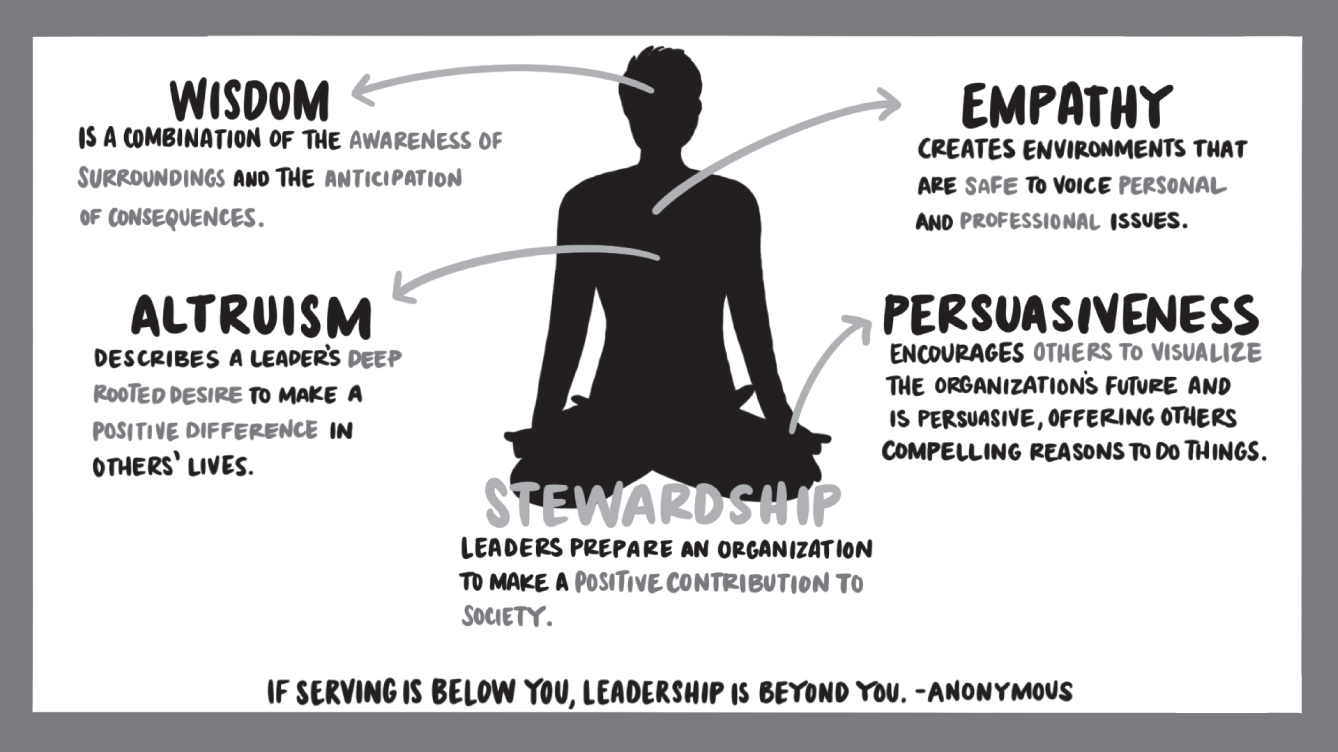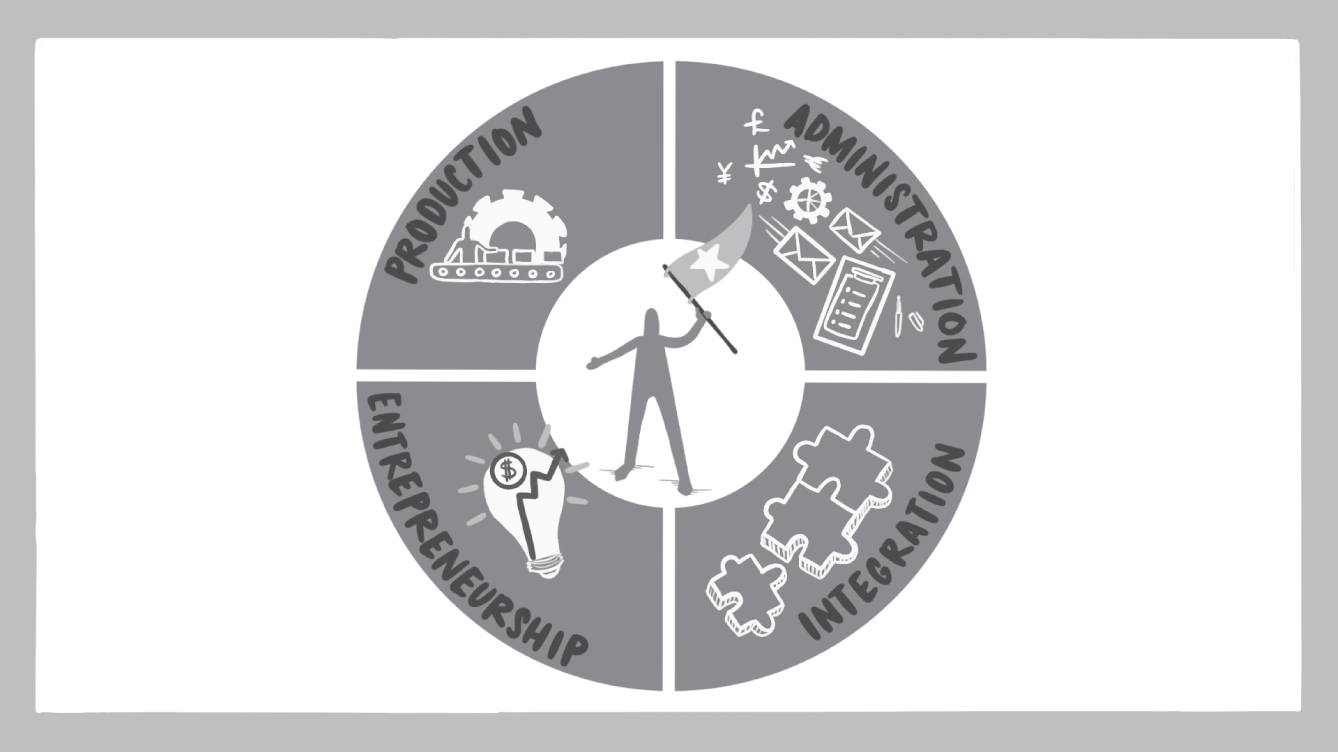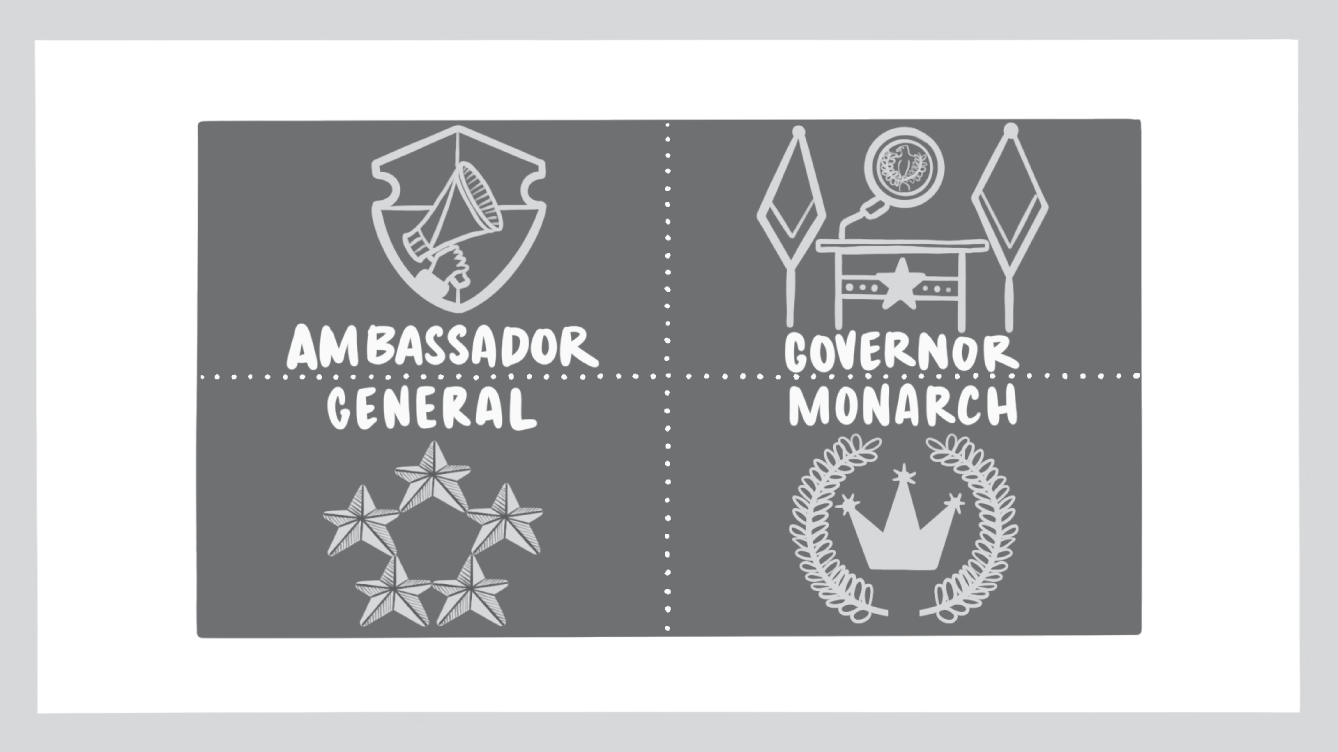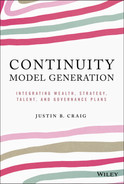Individual Meta-Framework
The sixteen dimensions that make up the four frameworks of the Individual meta-framework consider the gamut of questions everyone must answer at some point on their life journey. Most, if not all, relate to roles removed from those in the family business; such is their richness.
Five Servant Leadership Dimensions
Continuity, by its very nature, requires servant leaders. Barbuto and Wheeler’s (2006) servant leader dimensions of wisdom, empathy, altruism, persuasiveness, and stewardship reflect hallmark attributes and behaviors of the continuity model generation (Illustration 12).
- Wisdom can be understood as a combination of awareness of surroundings and anticipation of consequences. When leaders have both characteristics, they are adept at picking up cues from the environment and understanding their implications. Indeed, leaders high in wisdom are characteristically observant and anticipatory across most functions and settings (Bierly et al. 2000). Wisdom is the ideal union of perfect and practical, combining the height of knowledge and utility.
- Emotional healing (empathy) describes a leader's commitment to and skill in fostering spiritual recovery from hardship or trauma. Leaders who are highly empathetic and great listeners are adept at facilitating the healing process. In organizations, such leaders create environments that are safe for employees to voice personal and professional issues. Followers who experience personal traumas will also turn to leaders high in emotional healing.
- Altruistic calling (altruism) describes a leader's deep-rooted desire to make a positive difference in others’ lives. It is a generosity of the spirit consistent with a philanthropic purpose in life. Because the ultimate goal is to serve, leaders high in altruistic calling will put others’ interests ahead of their own and will diligently work to meet followers’ needs.
- Persuasive mapping (persuasiveness) describes the extent to which leaders use sound reasoning and mental frameworks. Leaders high in persuasive mapping are skilled at mapping issues and conceptualizing greater possibilities and are compelling when articulating these opportunities. They encourage others to visualize the organization's future, and motivate others to do things, without being coercive or manipulative.
- Organizational stewardship describes the extent to which leaders prepare an organization to make a positive contribution to society through community development, programs, and outreach. Such stewardship involves an ethic or value related to taking responsibility for the wellbeing of the community and making sure that the strategies and decisions undertaken reflect the commitment to give back and leave things better than found. Stewards also work to develop a community spirit in the workplace, laying the groundwork for leaving a positive legacy.
The concept of servant leadership has long been fundamental for the third generation Nelson family, and their global company, Kemin Industries. It is what drives their culture and their shared philosophy of management and leadership. To signal the importance of servant leadership in their organizational fiber, the family leadership team commissioned me to conduct a study in 2018 to further define servant leadership and establish, then monitor, how it mattered to their company. In other words, while the concept of servant leadership was firmly embedded in the organization, given the evolution to a future-focused global company, and being a science-based organization, the leaders thought it time to put some science (i.e. theory-based, empirical evidence) behind their philosophical approach to commerce.
The research team first confirmed that, according to the academic literature and extant studies, servant leaders focus on building a loving and caring community, generating a shared vision for helping others, and creating the freedom and resources for employees to become servants themselves, as their primary motivation is to serve others (Greenleaf 1977). Also, aligned with Greenleaf's (1977) warning that servant leadership would be difficult to operationalize, they learned that theoretical development of this construct had been slow partially because it is more than just a management technique but a way of life that begins with “the natural feeling that one wants to serve, to serve first” (Greenleaf 1977, p. 7). It was further confirmed that servant leadership is a multidimensional construct where the leader places the good of those being led over their own self-interest, emphasizes employee development, displays stewardship of organizational resources, builds community, and practices empathy, humility, and authenticity. Confirming the ‘Kemin Way’, servant leadership requires social exchanges that are long term, enduring, and ongoing, where individuals maintain consistency and fairness. Importantly, and very relevant to the Nelson family, the review of the servant leadership literature highlighted that by building a loving and caring community, servant leaders create a multigenerational legacy of serving others first. To refine our understanding and application of servant leadership, we utilized Barbuto and Wheeler's (2006) Servant Leadership Questionnaire (SLQ).
Organizational stewardship was most aligned with continuity and is defined as committing first and foremost to serving other's needs. Servant leaders recognize the role of organizations is to create people who will build a better tomorrow, and therefore, they build “people first” organizations that emphasize service. Organizational stewardship assumes responsibility for the wellbeing of others and ensures organizational strategies and decisions to make a positive difference. Servant-led organizations act as caretakers and role models working for the common interest of society, developing a community spirit in the workspace, and building a positive legacy. As Greenleaf (1977, p. 60) said, “the only way to change a society is to produce people, enough people, who will change it.” To servant leaders, organizations play a moral role in society to give back and make things better than when they found them.

Illustration 12 SERVANT LEADERSHIP FRAMEWORK
Four Tests Framework
The four tests framework is borrowed and paraphrased from arguably my favorite family enterprise article, which was authored by pioneering scholar-consultant, and Kellogg School of Management colleague, Professor Ivan Lansberg and published in the Harvard Business Review. The paper is well worth reading, then rereading. In fact, I advise anyone involved in business-owning families to become familiar with the paper, not necessarily with its intimate details, but at least with the broad concepts.
Like many of the frameworks included in the 21, it is possible to take a “napkin” perspective of the 4 tests. In the article, titled “The Four Tests of a Prince,” Lansberg shares that there are four tests or hurdles that individuals will need to pass, not just once but across their tenure of involvement with the family enterprise. This is true regardless of whether involvement is to be in an operational or governance role in the business or family, or as a contributor in any other capacity.
The four tests, specifically, are the qualifying test, the self-imposed test, the circumstantial test, and the political test (Illustration 13). First, the qualifying test. I use a simple question to paraphrase Lansberg's idea for this one: When reviewing an individual for a position or role, would an independent, objective evaluator agree that this person is qualified? For a typical (not family enterprise) interview process, it is likely that multiple people will have the same or equal qualifications, with impressive CVs and other supporting material. Only those most qualified will make the final cut, so being qualified is necessary but not sufficient; the independent, objective evaluator will look for other indications to make a decision. These indications can be discovered through the other three tests.
For the self-imposed test, the question is whether an independent, objective evaluator would see enough evidence that the candidate has imposed upon themselves sufficient discipline to address any shortcomings in their qualifications. An example could be that although an individual is well-qualified in terms of their academic pedigree, they have pursued industry involvement or pro bono work above and beyond that which is required of them in their previous roles. Or it might be that the person's undergraduate degree at a certain institution had a focus on marketing and, knowing that any future senior role in their field required advanced qualifications in finance or governance, they have complemented their undergraduate training with a master's focused on these areas: or the other way around, where they supplemented a finance degree with graduate work in marketing. So, while self-imposed tests are open to interpretation, an independent objective evaluator will generally be looking for something above the stated qualifications for the position. For the self-imposed test you could also include what work the person has undertaken to contribute to the development, implementation, or functioning of family governance roles, which are typically voluntary. Of course, like many of the 21 frameworks, the conversation this test requires is equally applicable to non-family business conversations.
The third of the four tests, the circumstantial test, involves behaviors that indicate, objectively, how the candidate has responded in situations that do not reflect “business as usual.” For example, someone might have volunteered to close down a non-performing division. So, this person ran toward the fire to put it out, rather than hiding and leaving difficult decisions and communications to someone else. The current COVID-19 pandemic offers a great context for such examples, as crises provide inspiring leaders the best chance to show their true strengths and potential. The independent objective evaluator understands that at some point the candidate's mettle will be tested by a crisis and having exposure to these unpredictable circumstances will hone their leadership and/or governance skills, or their preparedness to lead or govern.

Illustration 13 THE FOUR TESTS FRAMEWORK
The fourth test is the political test, which does not refer to politics. Rather, it is about the ability or capacity of the individual to navigate the often-turbulent political environment brought about by the utility heterogeneity in the ownership system, the diversity in expectations, engagement and skill levels of a growing family group, and the multiple agendas involved in managing the increasingly diverse portfolio of commercial activities. These three systems, combined, give rise to a potentially politically charged workplace, family place, and ownership place that requires a certain capacity and tolerance.
Being cognizant of these four individual meta-framework tests will help to develop a continuity model mindset.
Four Leadership Priorities
The leadership literature is massive. The most practical and applicable approach for continuity modelers uses the leadership concepts and conversations based on an organizational life cycle perspective. Dr. Ichak Adizes presents the most usable life cycle perspective, and I encourage anyone interested in further information on this to spend time on the adizes.com site. Here you will discover a very interactive, informative approach that includes normal and abnormal problems across the life cycle.
But most relevant to this conversation—and the stickiest concept in this domain—is to consider how the four core leadership priorities (defined below) vary across the life cycle (Illustration 14). The benefit of this is that Adizes, as did the Millers, developed a configuration approach. The continuity model generation needs to have configuration thinking in their armory. What this means, effectively, and it applies to many of the concepts introduced in these pages, is that the dimensions are all evident, but how they should be configured will vary. Examples of how this manifests into multiple configurations of a Continuity Canvas will be covered in Part III.
Now let's apply that thinking to Adizes's four leadership priorities. The four priorities are production, administration, integration, and entrepreneurship. The idea is that first there is a need to produce something. As a leader you have to focus on that initially, and at some point in the life cycle of the organization, administration becomes a priority. This eventually becomes unsustainable without integration across the various functions, once an entity reaches a certain level of maturity. And finally, without entrepreneurship there will be no chance of reinvention and innovation to change and adapt to the shifting environment.
So, a leader has to do two things. First, they have to understand that these functions (production, administration, integration, and entrepreneurship) should be their major foci. Then they need to understand how to configure them differently, depending on the life cycle of their organization. In the early stages of the business, for example, their focus will be on production and entrepreneurship. As the business venture evolves, they will continue to emphasize those priorities, but also administration. As things evolve even more, the focus on production may attenuate because that's in place already, but integration becomes a greater priority.
The most effective way to capture this changing configuration is to use either a capital or lowercase letter for each priority. The aim of the game, according to Adizes, is to get in the prime life cycle stage and stay in it. In the prime stage, the P (production), A (administration), I (integration), and E (entrepreneurship) are all in focus; they are joint priorities. Leading up to that point, they will be in different configurations. As I mentioned earlier, beyond the prime stage, in a mature organization, you'll find that entrepreneurship fades; it's important to be cognizant of this.
The Continuity Model Generation understands that looking through a life cycle lens reveals so much about the business's overall health. They will ensure as part of their mantra and their guiding principles, that the aim of the game is to get in prime and stay in prime, the life cycle stage where all four priorities of leadership are in concurrent focus. They are aware of the tendency in mature organizations for administration to rule the conversation, and to lose—or not prioritize—entrepreneurship and strategic risk-taking. Another mantra or guiding principle for leaders in emerging businesses or entities is to understand that their job is to prepare the organization for the next stage of the life cycle as it approaches nirvana, which is prime. Or, alternatively, to understand if they have moved from prime to maturity, how to move back to prime, the stage that can be depicted simply as P, A, I, E.

Illustration 14 FOUR LEADERSHIP PRIORITIES
Four Exit Strategies
Exiting significant, long-term career roles is difficult. Those who study this phenomenon, not necessarily in the family business context, have established that there are four exit strategies. Like the other 20 frameworks, the one for exits presents an efficient, effective way of understanding a potentially problematic topic for continuity modelers.
Here are the four established, role-based strategies to transition from a significant role in the business or family: ambassador, governor, general, and monarch (Illustration 15). Understanding these four exit strategies is useful. The preferred strategies are to depart as an ambassador or governor. Like many of the concepts and labels in the 21 framework dimensions, these are self-explanatory. An ambassador moves from an operational role to an ambassadorial role. The best example I have seen of this was when a CEO anointed his son to take over the business, and his announcement came with a message that he would still be involved in the business in an ambassador role. What this meant, and how it manifested, was that he was appointed by the board to promote and represent the business at specific events, as appropriate. The benefits of this are obvious. The message is clear, and it is recommended that some version of this is at least discussed with those leaving significant long-tenure leadership roles in operating businesses. But the idea is also relevant to board and family roles.
The second exit strategy is the governor. Here, the individual would move from an operational role to a governance role, as appropriate. This would ensure that their network continues to add value to the business, and provide a way for their institutional memory, typically substantial, to inform the next generation in their quest to continue differently. This governor role could be either in the family or in the business, as a full-time, paid non-executive director or in some meaningful advisory capacity. Again, it is worth the discussion to ensure individuals exit into a meaningful role and are able to continue to contribute.
The third exit strategy is known as the general. This strategy, which is non-optimal, occurs more often than it should. The idea is that the individual exits their role but plots their return, ready to make their move at the first sign of crisis, big or small. As soon as any cracks appear in their successor's way of handling the business or related activities, the general is ready to step in, typically with the mindset that the business cannot operate without them: just as a military commander would suggest that their troop or battalion wouldn't be as effective under someone else's lead. Again, this exit strategy is worthy of discussion and even to call out to a longtime leader who may be tempted to pursue it. Also, it can be wise to have directors put into place protocols, guidelines, and/or policies to ensure that a leader aspiring to general is directed into a governing or ambassadorial role, to minimize the chance of their reappearance.
The fourth exit strategy is not so much an exit strategy as a leadership right. That's because the monarch doesn't actually exit. They stay on the throne, typically, until they die or are overthrown. End of story (and the beginning of a new one).
Exit strategies, once identified, can be either formalized or guarded against. I recommend the formalizing of roles as either ambassadors and/or governors and guarding against the potential for leaving with all the pomp and ceremony of a military general, only to have the “departed” leader reappear in full battle fatigues in the not-so-distant future. And obviously if a monarch is in place, and sometimes that is appropriate, you must understand that there will be a time, potentially a sudden one, when there will be a transition to a new leader and to spend the time putting in place, formally or informally, structures and processes to ensure a smooth transition.
One thing we do know is that when matriarchs of families pass, there is a period of considerable flux. Some families have waited patiently while their mother or grandmother are still alive and have not been transparent about their discord-sowing intentions, so as to not upset this important family figure. But once she has passed, the glue that forms the bond and holds the family together dissolves. It's like when the gloves come off in a fight, catalyzing a bitter, often ongoing, often costly conflict. Understanding the probability that this will happen is a good starting point. Countering it in advance is highly recommended.
The four exit strategies speak for themselves in the context of continuity. For instance, if there is a monarchy in place and that leader will rule until they die, there needs to be a way to ensure that their ultimate demise does not negatively impact chances of continuity, as noted above. In general, continuity model generation members are conscious of the four exit strategies, and typically would guard against the generals and monarchs, and facilitate doing what it takes to make sure that governors and ambassadors are able to contribute meaningfully beyond their operational roles.

Illustration 15 FOUR EXIT STRATEGIES FRAMEWORK
